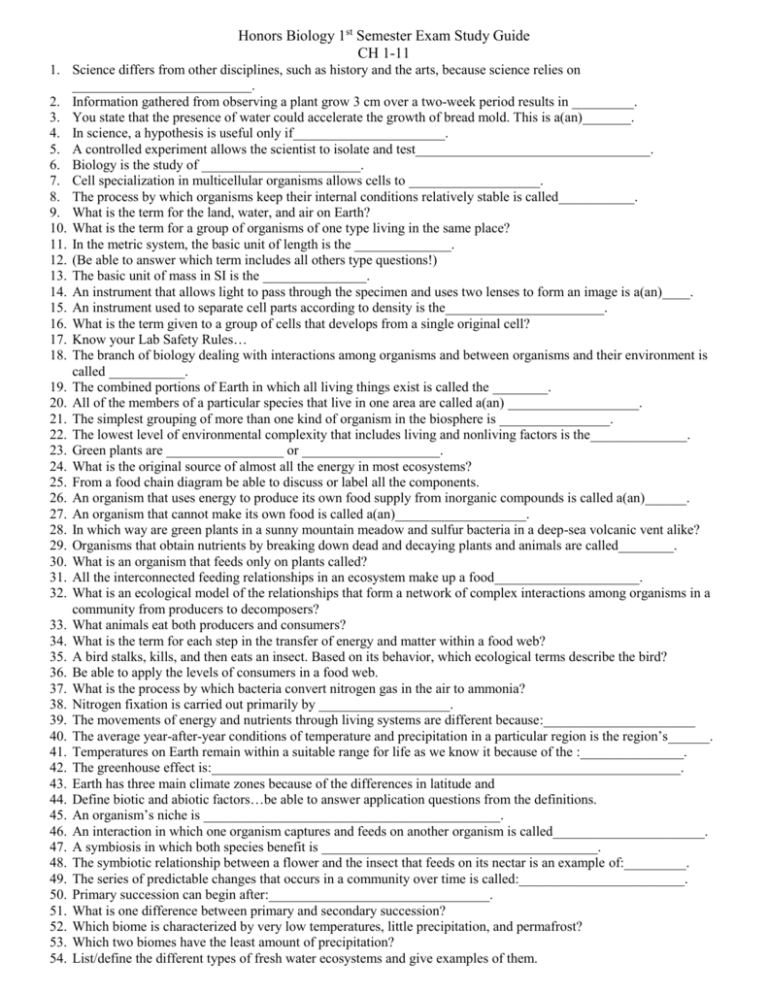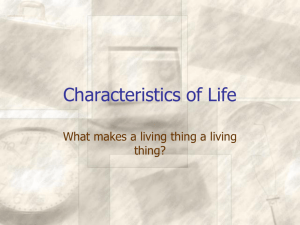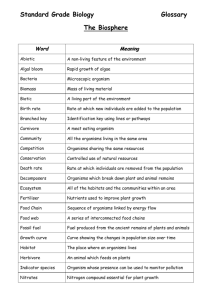Honors Biology 1st Semester Exam Study Guide
advertisement

Honors Biology 1st Semester Exam Study Guide CH 1-11 1. Science differs from other disciplines, such as history and the arts, because science relies on __________________________. 2. Information gathered from observing a plant grow 3 cm over a two-week period results in _________. 3. You state that the presence of water could accelerate the growth of bread mold. This is a(an)_______. 4. In science, a hypothesis is useful only if______________________. 5. A controlled experiment allows the scientist to isolate and test__________________________________. 6. Biology is the study of _______________________. 7. Cell specialization in multicellular organisms allows cells to ___________________. 8. The process by which organisms keep their internal conditions relatively stable is called___________. 9. What is the term for the land, water, and air on Earth? 10. What is the term for a group of organisms of one type living in the same place? 11. In the metric system, the basic unit of length is the ______________. 12. (Be able to answer which term includes all others type questions!) 13. The basic unit of mass in SI is the _______________. 14. An instrument that allows light to pass through the specimen and uses two lenses to form an image is a(an)____. 15. An instrument used to separate cell parts according to density is the_______________________. 16. What is the term given to a group of cells that develops from a single original cell? 17. Know your Lab Safety Rules… 18. The branch of biology dealing with interactions among organisms and between organisms and their environment is called ___________. 19. The combined portions of Earth in which all living things exist is called the ________. 20. All of the members of a particular species that live in one area are called a(an) ___________________. 21. The simplest grouping of more than one kind of organism in the biosphere is ________________. 22. The lowest level of environmental complexity that includes living and nonliving factors is the______________. 23. Green plants are _________________ or ____________________. 24. What is the original source of almost all the energy in most ecosystems? 25. From a food chain diagram be able to discuss or label all the components. 26. An organism that uses energy to produce its own food supply from inorganic compounds is called a(an)______. 27. An organism that cannot make its own food is called a(an)___________________. 28. In which way are green plants in a sunny mountain meadow and sulfur bacteria in a deep-sea volcanic vent alike? 29. Organisms that obtain nutrients by breaking down dead and decaying plants and animals are called________. 30. What is an organism that feeds only on plants called? 31. All the interconnected feeding relationships in an ecosystem make up a food_____________________. 32. What is an ecological model of the relationships that form a network of complex interactions among organisms in a community from producers to decomposers? 33. What animals eat both producers and consumers? 34. What is the term for each step in the transfer of energy and matter within a food web? 35. A bird stalks, kills, and then eats an insect. Based on its behavior, which ecological terms describe the bird? 36. Be able to apply the levels of consumers in a food web. 37. What is the process by which bacteria convert nitrogen gas in the air to ammonia? 38. Nitrogen fixation is carried out primarily by ___________________. 39. The movements of energy and nutrients through living systems are different because:______________________ 40. The average year-after-year conditions of temperature and precipitation in a particular region is the region’s______. 41. Temperatures on Earth remain within a suitable range for life as we know it because of the :_______________. 42. The greenhouse effect is:____________________________________________________________________. 43. Earth has three main climate zones because of the differences in latitude and 44. Define biotic and abiotic factors…be able to answer application questions from the definitions. 45. An organism’s niche is ___________________________________________. 46. An interaction in which one organism captures and feeds on another organism is called______________________. 47. A symbiosis in which both species benefit is ________________________________________. 48. The symbiotic relationship between a flower and the insect that feeds on its nectar is an example of:_________. 49. The series of predictable changes that occurs in a community over time is called:________________________. 50. Primary succession can begin after:________________________________. 51. What is one difference between primary and secondary succession? 52. Which biome is characterized by very low temperatures, little precipitation, and permafrost? 53. Which two biomes have the least amount of precipitation? 54. List/define the different types of fresh water ecosystems and give examples of them. 55. Which factors play a role in population growth? 56. There are 150 Saguaro cacti plants per square kilometer in a certain area of Arizona desert. To which population characteristic does this information refer? 57. What does the range of a population tell you that density does not? 58. The movement of organisms into a given area from another area, is called 59. When organisms move out of the population, this is known as 60. The various growth phases through which most populations go are represented on a(an) 61. In a logistic growth curve, exponential growth is the phase in which the population_________________________________. 62. Define density dependent limiting factor and density independent limiting factor and give examples of each. 63. The work of Schleiden and Schwann can be summarized by saying :____________________________. 64. The cell theory applies to:_______________________________________________; 65. Know basic cell organelles and their function…be able to label. 66. Which cell structure contains the cell’s genetic material and controls the cell’s activities? 67. Define prokaryote and eukaryote…know examples of each and main compare contrast of the two. 68. Which organelle makes proteins using coded instructions that come from the nucleus? 69. Which organelles help provide cells with energy? 70. Which organelle would you expect to find in plant cells but not animal cells? 71. Define diffusion. 72. Define active and passive transport. Give examples of each. 73. Energy is released from ATP when:________________________________________ 74. Know the equation for photosynthesis and cellular respiration. 75. Why do plants appear green? 76. he Calvin cycle is another name for_____________________________. 77. What is a product of the Calvin cycle? 78. Cellular respiration releases energy by breaking down_____________________. 79. Breathing heavily after running a race is your body’s way of:__________________________________. 80. When the body needs to exercise for longer than 90 seconds, it generates ATP by carrying out__________________. 81. What happens to a cell as it becomes larger? 82. The process by which a cell divides into two daughter cells is called 83. When during the cell cycle are chromosomes visible? 84. List and describe the phases of mitosis…in order. 85. What happens when cells come into contact with other cells? 86. Gregor Mendel concluded that traits are: 87. Define homozygous and heterozygous and be able to recognize and apply both. 88. Be able to work genetic crosses; 89. What is meiosis? How does it compare to mitosis? 90. Define diploid and haploid? Be able to apply both.








